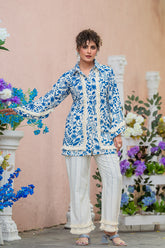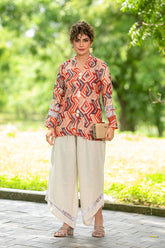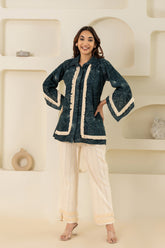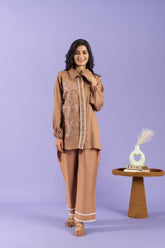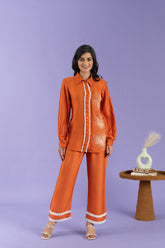The Intersection of Fashion and Technology: Innovation, and Immersive Fashion Tech in the Industry
What is the Role of Innovation in Women’s Fashion
Innovation is pivotal in redefining women’s fashion by introducing advanced technologies like The integration of smart fabrics is a significant advancement of technology in the fashion industry., AI-driven design tools, and 3D printing. These advancements allow designers to experiment with functionality and customization. From creating adaptive clothing to reducing waste in production, Innovation in technology and fashion is crucial for the future of the fashion industry. Ensures that fashion remains relevant and forward-thinking while meeting the evolving needs of consumers.
The fashion industry is adopting a more approach to fashion by using eco-friendly materials, recycling textiles, and implementing circular economy models. Brands reduce water usage, minimize waste, and incorporate renewable energy in production. Additionally, blockchain technology is used to enhance supply chain transparency, ensuring ethical sourcing and promoting accountability across the industry.
What are some examples of innovation in apparel design?
Apparel design has seen remarkable such as modular clothing that can be reconfigured, garments made with 3D printing technology, and textiles embedded with performance-enhancing features like UV protection or moisture-wicking. These advancements not only improve functionality but also offer solutions by reducing material waste and extending the lifecycle of clothing.
How does technology continue to evolve within the fashion industry?
Technology continues to evolve within the fashion industry by streamlining processes and enhancing creativity. AI-powered forecasting predicts trends with precision, while automation accelerates production timelines. Virtual prototyping tools enable designers to visualize concepts digitally before manufacturing, and digital fashion items are expanding creative possibilities in virtual spaces.
How Are Augmented Reality and Virtual Reality Changing the Shopping Experience
Virtual and Augmented reality (AR) and VR are transforming the shopping experience being revolutionized by advancements in technology and fashion. By offering tools like virtual try-ons and interactive showrooms. AR allows customers to visualize how clothes fit or look without leaving the comfort of their homes, while VR creates engaging environments where shoppers can explore collections virtually. These technologies enhance convenience and boost customer confidence.
What is augmented reality (AR) and how is it used in fashion shopping
AR overlays digital elements in the real world, allowing customers to interact with products virtually. In fashion shopping, AR enables users to "try on clothes" or accessories through their devices, helping them make informed decisions. This technology enhances the overall shopping experience by providing a seamless blend of physical and digital retail.
How do virtual fashion shows promote fashion brands
Virtual shows revolutionize how brands showcase their collections by reaching global audiences without geographical constraints. These shows use advanced visuals and immersive storytelling to highlight designs while reducing costs and environmental impact compared to traditional runway events. They also help brands connect with tech-savvy consumers.
What immersive technologies enhance customer experience in fashion
Technologies like AR, VR, and 3D visualization tools elevate the customer by making shopping more interactive and engaging. These tools allow customers to explore products in detail, try on outfits virtually, or customize designs before purchase, creating a personalized journey that blends convenience.
What is the Future of Fashion
The lies in embracing sustainability through innovative practices like zero-waste manufacturing, ethical sourcing via blockchain, and resource-efficient technologies such as 3D printing technology. By prioritizing eco-friendly approaches at every stage of production, the industry can reduce its environmental footprint while meeting consumer demand for responsible fashion.
How is sustainable fashion transforming the fashion industry
Fashion is reshaping the industry by encouraging brands to adopt practices that minimize environmental harm. This includes using biodegradable materials, recycling old garments into new ones, and promoting slow fashion over fast fashion. Such transformations not only reduce waste but also align with consumer values for ethical consumption.
What role does 3D printing play in sustainable apparel production
3D printing technology contributes to production by enabling precise manufacturing with minimal material waste. It allows designers to create intricate patterns without excess fabric and supports on-demand production models that reduce overstocking. This aligns with efforts to make the industry more eco-friendly.
How can blockchain technology support supply chains
Blockchain enhances supply chain transparency by recording every step of a product’s journey—from raw material sourcing to final delivery. This ensures ethical practices are followed while giving consumers confidence in their purchases. It also helps brands monitor their environmental impact more effectively.
How is Wearable Technology Reshaping Fashion Consumption
Blending functionality with style in women’s fashion. From fitness trackers embedded in clothing to smart textiles that regulate temperature or monitor health metrics, these are reshaping how consumers interact. They enhance convenience while offering new ways to integrate technology into daily life.
What types of technology are popular in women’s fashion
Popular include fitness trackers integrated into activewear, smart jewelry that syncs with devices, and clothing made from responsive textiles that adjust based on body temperature or activity levels. These items combine practicality with aesthetics, appealing to modern consumers seeking multifunctional products.
How do smart fabrics contribute to the future of fashion
Smart fabrics are revolutionizing fashion by incorporating advanced features like moisture-wicking properties, UV protection, or embedded sensors for health monitoring. These textiles not only enhance comfort but also open new possibilities for functional clothing that adapts to individual needs.
What impact does wearable technology have on customer experience
Improves the experience by offering personalized features such as health tracking or connectivity through smart devices. It allows users to seamlessly integrate technology into their daily lives while enjoying stylish designs that cater to both form and function.
What Driving the Fashion Tech Movement
The fusion of fashion and technology drives through tools like AI-powered design systems, virtual prototyping platforms, and retail experiences using AR/VR. These advancements streamline processes while enhancing creativity, efficiency, and customer engagement within the evolving landscape of fashion tech.
How are fashion designers using digital technology in their design process?
Fashion designers are leveraging digital technology to revolutionize their creative processes. Tools like CAD (Computer-Aided Design) and 3D modeling software enable designers to visualize and refine garments digitally, reducing the need for physical prototypes. Technologies such as 3D printing allow for rapid prototyping, intricate designs, and customization. Virtual sampling platforms like CLO3D and Browzwear streamline collaboration by enabling real-time adjustments and feedback. These advancements not only enhance efficiency but also promote sustainability by minimizing material waste.
What are the benefits of integrating fashion tech into traditional fashion?
Integrating fashion tech into traditional fashion enhances efficiency, sustainability, and creativity. Automation reduces production timelines while improving precision, and AI-driven insights optimize inventory management and trend forecasting. Digital platforms allow for personalized shopping experiences and virtual try-ons, bridging the gap between physical and online retail. Additionally, tools like 3D printing support practices by reducing waste and enabling on-demand production
How is the fusion of fashion and technology revolutionizing fashion
The fusion of fashion and technology is transforming fashion into digital experiences. Virtual reality (VR) enables brands to host interactive runway events that reach global audiences without physical constraints. Augmented reality (AR) enhances presentations by overlaying digital elements onto real-world settings, showcasing the advancement of technology in fashion. These fashion design shows are more accessible, and engaging, as seen in Balenciaga’s virtual reality showcases or Tommy Hilfiger’s AR try-on feature.
How is the Supply Chain Affected by Technology in Fashion
Technology is reshaping the supply chain in the fashion industry by improving transparency, efficiency, and adaptability. AI-powered tools optimize demand forecasting and inventory management, while blockchain ensures ethical sourcing through traceable records. IoT sensors provide real-time tracking of materials, enhancing supply chain visibility. These advancements streamline operations, reduce waste, and promote sustainability across the production cycle in the sustainable fashion industry.
What advancements in textile technology are reshaping the supply chain
Advancements in textile technology include AI-driven analytics, automated machinery, and IoT-enabled tracking systems. These innovations enhance quality control, reduce production times, and improve inventory management. Technologies like digital twins allow for the virtual prototyping of textiles, while sustainable materials such as recycled fibers are gaining prominence in the sustainable fashion industry. These developments make supply chains more efficient, transparent, and eco-friendly.
How has technology improved efficiency in fashion production
Technology has significantly improved efficiency in fashion production through automation, AI integration, and digital solutions. Automated sewing machines and computerized cutting tools reduce manual labor while increasing speed and accuracy. AI optimizes resource allocation by predicting consumer demand and managing inventory effectively. Virtual prototyping eliminates the need for physical samples, reducing lead times and costs.
What challenges remain in the intersection of technology?
Despite technological advancements, challenges persist at the intersection of technology and Luxury fashion. High implementation costs limit access for smaller brands while ensuring widespread adoption across global supply chains remains a hurdle. Balancing innovation with affordability is critical to achieving sustainability goals. Additionally, ethical concerns around data privacy in AI-driven systems must be addressed to build consumer trust.

